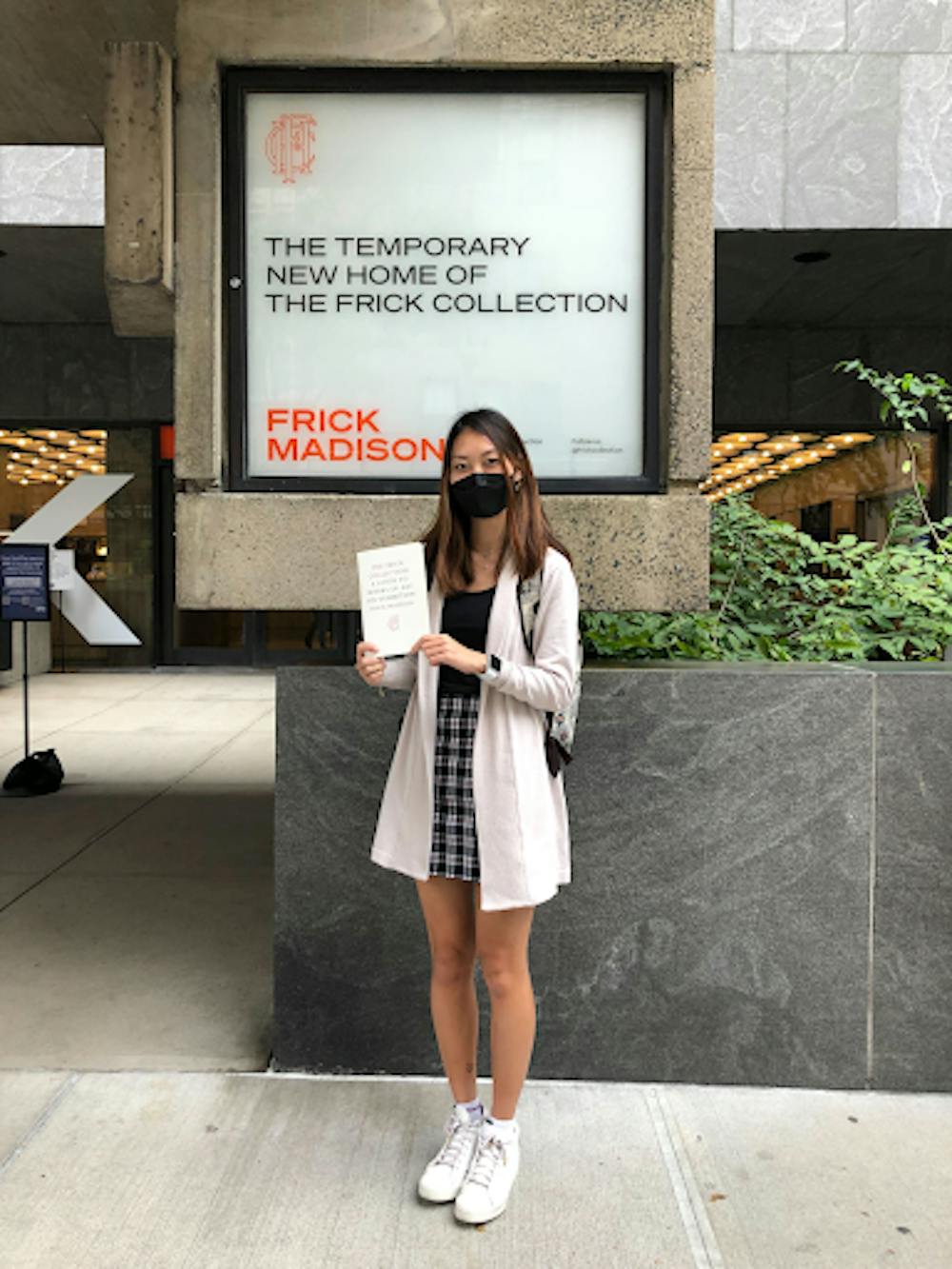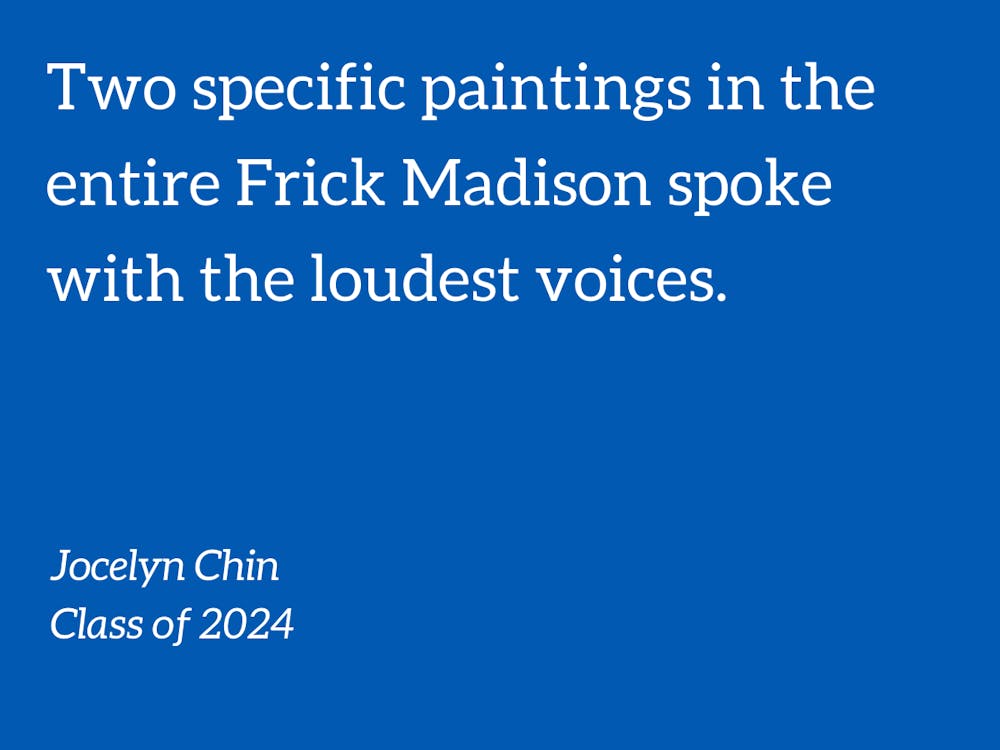
Rembrandt! Van Dyck! Goya! Degas! These names sang gloriously in their gold plaques on filigree frames. I couldn’t help but stare a little harder at these paintings shining in their auras of fame, the large and gently cracked faces holding my attention as I attempted to decipher how these paintings made the painter who they are today. I stared especially hard at Rembrandt’s 1658 self-portrait which caught me by surprise, his deep gaze piercing into mine after I rounded a corner on the second floor. I had no idea this iconic piece belonged to the Frick Collection, and around every turn and upon entry into each new room, another pair of awe-inspiring, oil-on-canvas eyes bore into mine.
The entire air about Frick Madison — temporary yet refined — is one of high class and authority. Collected by the late-19th-century industrialist Henry Clay Frick, how could these pieces of art not exude the same sort of Gilded Age energy? Visitors were near-silent, photos were not allowed in galleries, and the security guards were more abundant and more well-dressed here than any other art gallery I’ve visited. In the hushed environment, however, I was actually able to focus so much more on the art itself, able to admire the specific ambiance of a silent room of priceless art.
Yet as I walked through each floor slowly, I couldn’t help but feel an eerie sense of being out of place. At first I attributed this feeling to the deathly silence and the guards’ stern brows. Yet as I continued exploring, I suddenly realized that I perhaps felt out of place being one of the only people of color in the room, whether on or off the canvas. There were multiple elderly white couples milling about, a few young people too. But the art, too, was astonishingly white, which of course made sense, being that this was a collection of European artwork, sans the two rooms of Asian porcelain and Indian carpets on the third floor.
This situation immediately reminded me of a comment made by Duke in New York Professor Weinstein in one of our first classes, something along these lines: “Even when you walk into art museums like the Met, immediately you have these Greek and Roman columns. How can you talk of making museums less Eurocentric when the architecture itself is this!” In the same way, how can I hope for there to be greater diversity and representation of all human beings in fine art, when our expectations of fine art are portraits of these rich Dutch, Italian, French or British individuals from the 13th to 19th centuries?
This is why two specific paintings in the entire Frick Madison spoke with the loudest voices. They are part of an installation called “Living Histories: Queer Views and Old Masters.” Four paintings by modern New York-based artists are being rotated throughout the galleries in conversation with “old masters’” paintings, meant to emphasize “issues of gender and queer identity typically excluded from narratives of early modern European art.”
The two on display the day I visited were Doron Langberg’s Lover and Salman Toor’s Museum Boys. Langberg’s paintings are described as an “intimate yet expansive take on relationships, sexuality, nature, family, and the self,” and the vivid tactility of Lover, contrasting Hans Holbein the Younger’s dark and serious portrait of Sir Thomas More, certainly demonstrated the Langberg’s proclivity for the colorful, lively, and borderline erotic.
As for Toor’s Museum Boys, it really jumped out of nowhere, jerking me back to reality from the high clouds of Baroque. Two pieces by Vermeer, one of the most widely known 17th-century Dutch artists, hang perpendicular to each other in this room. Next Mistress and Maid hangs Museum Boys. It leaps off the wall, being a bright, almost grotesque shade of green. It is almost frightening in its boldness and unabashed surrealism; I can’t quite describe it well enough to do it justice. As this Frick Madison Press Release described, “whereas the objects in Vermeer’s paintings illustrate the growing influence of the Dutch Republic on international trade, the surreal menagerie in Toor’s painting conjures queer mythology and colonial plunder.... Toor’s Museum Boys is a sultry, sidelong glance at the canonical world of the Old Masters.”
So, my initial reaction when observing these paintings in conversation was: props to Frick Madison. Thank you for being quite in touch with the times. As I left, I jotted down “I highly recommend this place to any NYC visitor, as it so well blends the old high and mighty world with our current culture of accessibility, representation, and subversion of what finery a generation before us may take for granted.”
Yet, as I further considered my visit, I recalled that these paintings will only remain till January 2022. While yes, it’s fair to separate contemporary pieces from the old for aesthetic and historical purposes, by making “Living Histories” a special, temporary exhibit, these narratives remain excluded from longstanding, “finer,” “Old Master” art. Even the Frick Madison is a temporary home for the Frick Collection as the museum’s original home five blocks away on East 70th remains under construction. At this new location, Xavier F. Salomon, Deputy Director, hopes that Frick Madison can fulfill Breuer’s promise to “transform the vitality of the street into the sincerity and profundity of art.”
Arguably, the new location itself is not what connects the art to the streets of New York, nor what fulfills Salomon’s hopes; rather, the intentional placement of modern, Queer views against and alongside the Old Master paintings is what reveals art and its narratives to be profound. As Professor Weinstein noted, even while Henry Frick himself collected, “art history was focused on the Renaissance and Baroque. By contrast, even modern art was something no serious academic would trifle with. This bias is preserved in the collection we have today.”
How can we continue to rid ourselves and our consumption of art of these biases? Instead of creating an extra wall on which to place a modern painting for a few months, I hope we can see a blend of fresh narratives into our conventional views. Even outside of the sphere of art galleries, in our workplaces and schools, let’s stop taking well-intentioned special spaces for minority groups for granted, and rather accept that these voices are, in reality, quite ordinary — perhaps you have just yet to make this your reality. I wonder, how sincere and profound are your galleries showcasing queer and diverse art, if they remain as temporary pop-up installments? When the construction is over, and the Frick Madison and “Living Histories” are no more, will Lover and Museum Boys live on?
Jocelyn Chin is a Trinity sophomore. Her column runs on alternate Wednesdays.
Get The Chronicle straight to your inbox
Signup for our weekly newsletter. Cancel at any time.
Jocelyn Chin is a Trinity junior and an opinion managing editor of The Chronicle's 118th volume.

